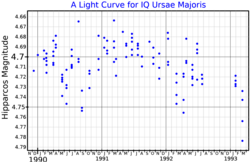83 Ursae Majoris is a candidate binary star[11] system in the northern circumpolar constellation of Ursa Major. It is a semiregular variable star, and it has been given the variable star designation IQ Ursae Majoris. It ranges in brightness from apparent visual magnitude 4.69 to 4.75.[3] Percy and Au (1994) identified it as a small amplitude red variable with an irregular behavior, having a characteristic time scale of 20 days.[12] Based upon an annual parallax shift of 6.23±0.22 mas,[2] it is located roughly 520 light years from the Sun. The distance derived from its Gaia Early Data Release 3 parallax is 179 pc.[13] The system is moving closer with a heliocentric radial velocity of −18.6[6] km/s.
| Observation data Epoch J2000 Equinox J2000 | |
|---|---|
| Constellation | Ursa Major |
| Right ascension | 13h 40m 44.27335s[2] |
| Declination | +54° 40′ 53.8891″[2] |
| Apparent magnitude (V) | 4.69 - 4.75[3] |
| Characteristics | |
| Spectral type | M2 III[4] |
| B−V color index | +1.630±0.006[5] |
| Variable type | SRb[3] |
| Astrometry | |
| Radial velocity (Rv) | −18.61±0.20[6] km/s |
| Proper motion (μ) | RA: −19.06[2] mas/yr Dec.: −10.56[2] mas/yr |
| Parallax (π) | 6.23 ± 0.22 mas[2] |
| Distance | 520 ± 20 ly (161 ± 6 pc) |
| Absolute magnitude (MV) | −1.39[5] |
| Details | |
| Mass | 1.1[7] M☉ |
| Radius | 80[8] R☉ |
| Luminosity | 1,250[9] L☉ |
| Surface gravity (log g) | 0.62[7] cgs |
| Temperature | 3,579[7] K |
| Metallicity [Fe/H] | −0.07[7] dex |
| Other designations | |
| Database references | |
| SIMBAD | data |
The visible component is an evolved red giant with a stellar classification of M2 III.[4] It is a marginal barium star, showing an enhanced abundance of s-process elements in its outer atmosphere. This material may have been acquired during a previous mass transfer from a now white dwarf companion, or self-enriched by a dredge-up during the asymptotic giant branch process.[14]
References edit
- ^ "Hipparcos Tools Interactive Data Access". Hipparcos. ESA. Retrieved 8 December 2021.
- ^ a b c d e f van Leeuwen, F. (2007), "Validation of the new Hipparcos reduction", Astronomy and Astrophysics, 474 (2): 653–664, arXiv:0708.1752, Bibcode:2007A&A...474..653V, doi:10.1051/0004-6361:20078357, S2CID 18759600.
- ^ a b c Samus, N. N.; et al. (2017), "General Catalogue of Variable Stars: Version GCVS 5.1", Astronomy Reports, 61 (1): 80–88, Bibcode:2017ARep...61...80S, doi:10.1134/S1063772917010085, S2CID 125853869.
- ^ a b Keenan, Philip C.; McNeil, Raymond C. (1989), "The Perkins catalog of revised MK types for the cooler stars", The Astrophysical Journal Supplement Series, 71: 245, Bibcode:1989ApJS...71..245K, doi:10.1086/191373, S2CID 123149047.
- ^ a b Anderson, E.; Francis, Ch. (2012), "XHIP: An extended hipparcos compilation", Astronomy Letters, 38 (5): 331, arXiv:1108.4971, Bibcode:2012AstL...38..331A, doi:10.1134/S1063773712050015, S2CID 119257644.
- ^ a b De Bruijne, J. H. J.; Eilers, A.-C. (2012), "Radial velocities for the HIPPARCOS-Gaia Hundred-Thousand-Proper-Motion project", Astronomy & Astrophysics, 546: A61, arXiv:1208.3048, Bibcode:2012A&A...546A..61D, doi:10.1051/0004-6361/201219219, S2CID 59451347.
- ^ a b c d Anders, F.; Khalatyan, A.; Chiappini, C.; Queiroz, A. B.; Santiago, B. X.; Jordi, C.; Girardi, L.; Brown, A. G. A.; Matijevič, G.; Monari, G.; Cantat-Gaudin, T.; Weiler, M.; Khan, S.; Miglio, A.; Carrillo, I.; Romero-Gómez, M.; Minchev, I.; de Jong, R. S.; Antoja, T.; Ramos, P.; Steinmetz, M.; Enke, H. (August 2019), "Photo-astrometric distances, extinctions, and astrophysical parameters for Gaia DR2 stars brighter than G = 18", Astronomy & Astrophysics, 628: A94, arXiv:1904.11302, Bibcode:2019A&A...628A..94A, doi:10.1051/0004-6361/201935765, ISSN 0004-6361.
- ^ Stassun, Keivan G.; et al. (2019-10-01), "The Revised TESS Input Catalog and Candidate Target List", The Astronomical Journal, 158 (4): 138, arXiv:1905.10694, Bibcode:2019AJ....158..138S, doi:10.3847/1538-3881/ab3467, hdl:1721.1/124721, ISSN 0004-6256, S2CID 166227927.
- ^ Chandler, Colin Orion; McDonald, Iain; Kane, Stephen R. (2016), "The Catalog of Earth-Like Exoplanet Survey Targets (CELESTA): A Database of Habitable Zones Around Nearby Stars", The Astronomical Journal, 151 (3): 59, arXiv:1510.05666, Bibcode:2016AJ....151...59C, doi:10.3847/0004-6256/151/3/59, S2CID 119246448.
- ^ "83 UMa". SIMBAD. Centre de données astronomiques de Strasbourg. Retrieved 2018-03-31.
- ^ Eggleton, P. P.; Tokovinin, A. A. (September 2008), "A catalogue of multiplicity among bright stellar systems", Monthly Notices of the Royal Astronomical Society, 389 (2): 869–879, arXiv:0806.2878, Bibcode:2008MNRAS.389..869E, doi:10.1111/j.1365-2966.2008.13596.x, S2CID 14878976.
- ^ Percy, John R.; Au, Winnie (November 1994), "APT Observations of Small-Amplitude Red Variables", Information Bulletin on Variable Stars, 4114: 1, Bibcode:1994IBVS.4114....1P.
- ^ Bailer-Jones, C. A. L.; Rybizki, J.; Fouesneau, M.; Demleitner, M.; Andrae, R. (2021), "Estimating Distances from Parallaxes. V. Geometric and Photogeometric Distances to 1.47 Billion Stars in Gaia Early Data Release 3", The Astronomical Journal, 161 (3): 147, arXiv:2012.05220, Bibcode:2021AJ....161..147B, doi:10.3847/1538-3881/abd806, S2CID 228063812.
- ^ Gomez, A. E.; et al. (1997), "Absolute magnitudes and kinematics of barium stars", Astronomy and Astrophysics, 319: 881, Bibcode:1997A&A...319..881G.
